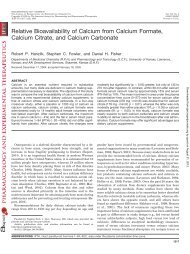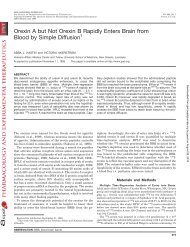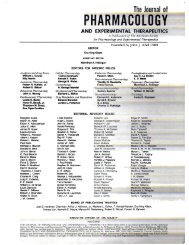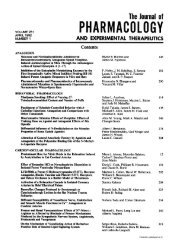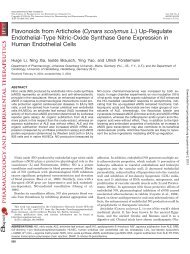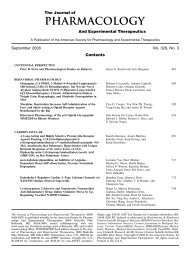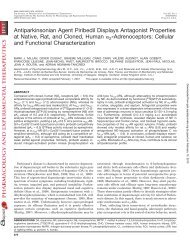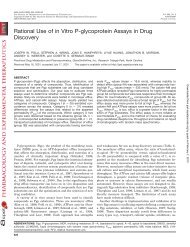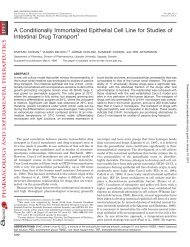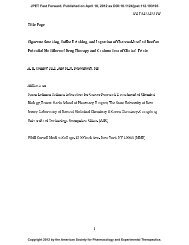Dopaminergic Agonists and Muscarinic Antagonists Improve ...
Dopaminergic Agonists and Muscarinic Antagonists Improve ...
Dopaminergic Agonists and Muscarinic Antagonists Improve ...
You also want an ePaper? Increase the reach of your titles
YUMPU automatically turns print PDFs into web optimized ePapers that Google loves.
0022-3565/04/3092-737–744$20.00<br />
THE JOURNAL OF PHARMACOLOGY AND EXPERIMENTAL THERAPEUTICS Vol. 309, No. 2<br />
Copyright © 2004 by The American Society for Pharmacology <strong>and</strong> Experimental Therapeutics 59519/1143745<br />
JPET 309:737–744, 2004<br />
Printed in U.S.A.<br />
<strong>Dopaminergic</strong> <strong>Agonists</strong> <strong>and</strong> <strong>Muscarinic</strong> <strong>Antagonists</strong> <strong>Improve</strong><br />
Lateralization in Hemiparkinsonian Rats in a Novel Exploratory<br />
Y-Maze<br />
Makoto Nakagawa, Makoto Ohgoh, Yukio Nishizawa, <strong>and</strong> Hiroo Ogura<br />
Tsukuba Research Laboratories, Eisai Co., Ltd., Ibaraki, Japan<br />
Received September 5, 2003; accepted January 28, 2004<br />
Parkinson’s disease (PD) is a progressive neurological disorder<br />
affecting mainly elderly people. In this disease, the<br />
degeneration of nigrostriatal dopaminergic neurons is evident,<br />
as revealed by direct biochemical assay (Hornykiewicz,<br />
1966, 1998) <strong>and</strong> more recently by positron emission tomography,<br />
measuring the uptake of the dopamine precursor 18 F-<br />
DOPA (Brooks et al., 1990; Takikawa et al., 1994). A deficit<br />
in this dopaminergic input into the striatum causes overactivity<br />
in the indirect motor pathway accompanied with underactivity<br />
in the direct motor pathway in the basal ganglia<br />
(Wichmann <strong>and</strong> DeLong, 1993). The imbalance of these motor<br />
circuits leads to motor dysfunction, including akinesia<br />
(impaired initiation of movement) <strong>and</strong> bradykinesia (reduced<br />
amplitude <strong>and</strong> velocity of voluntary movement), which produce<br />
the characteristic features of PD (Kish et al., 1988).<br />
The immediate metabolic precursor of dopamine, levodopa<br />
(L-3,4-dihydroxyphenylalanine, L-dopa), has been used in<br />
Article, publication date, <strong>and</strong> citation information can be found at<br />
http://jpet.aspetjournals.org.<br />
DOI: 10.1124/jpet.103.059519.<br />
ABSTRACT<br />
Parkinson’s disease (PD) is characterized by the degeneration<br />
of nigrostriatal dopaminergic neurons. Its primary clinical symptoms<br />
are akinesia, tremor, <strong>and</strong> rigidity, which usually start from<br />
one side, resembling the lateralization in hemiparkinsonian rats<br />
having 6-hydroxydopamine-induced unilateral lesion of the medial<br />
forebrain bundle. A novel exploratory Y-maze was designed<br />
to detect the lateralization of hemiparkinsonian rats in<br />
terms of biased turns in the maze. Dopamine agonists levodopa<br />
(L-3,4-dihydroxyphenylalanine, 10–30 mg/kg) <strong>and</strong> apomorphine<br />
(0.1–0.3 mg/kg), but not methamphetamine (0.5–2 mg/<br />
kg), improved the lateralization in the rat model. However, high<br />
doses of the dopamine agonists, 30 <strong>and</strong> 0.3 mg/kg, respectively,<br />
caused small movements in the arms that seemed to<br />
parallel the increase in counts per turn in the Y-maze. Interestingly,<br />
the muscarinic antagonists trihexyphenidyl <strong>and</strong> scopolamine<br />
improved lateralization moderately, while increasing total<br />
turns, an index of locomotive activity. ()-5-Methyl-10,11-dihydro-5H-dibenzo[a,d]cyclohepten-5,10-imine<br />
maleate (MK-801)<br />
(0.3 mg/kg), an N-methyl-D-aspartate (NMDA) glutamate receptor<br />
antagonist, increased total counts, but did not alleviate the<br />
lateralization. The 2-adrenoceptor antagonist idazoxan (1 <strong>and</strong><br />
10 mg/kg) <strong>and</strong> 2,3-dihydroxy-6-nitro-7-sulfamoylbenzo(f)quinoxaline<br />
(1 <strong>and</strong> 3 mg/kg), a non-NMDA glutamate receptor<br />
antagonist, did not affect any of the indices. These findings<br />
suggest that the clinical action of drugs on unbalanced movement<br />
in PD could be predicted by measuring their effects on<br />
lateralization of the 6-hydroxydopamine-lesioned rat model in<br />
this exploratory Y-maze.<br />
medications for the treatment of PD. It provides a drastic<br />
reversal of all signs <strong>and</strong> symptoms of PD except dementia<br />
<strong>and</strong> postural instability (Williams <strong>and</strong> Carlyle, 1979; Silver<br />
<strong>and</strong> Ruggieri, 1998). Historically, direct dopamine agonists,<br />
such as bromocriptine <strong>and</strong> pergolide, have also been used as<br />
adjuncts to levodopa in patients with advanced disease who<br />
already have motor complications (Olanow et al., 2001). However,<br />
it has recently been demonstrated that initiation of<br />
therapy with a direct dopamine agonist is associated with a<br />
reduced risk for development of motor complications to levodopa<br />
(Watts, 1997; Poewe, 1998). Until levodopa was introduced,<br />
muscarinic antagonists had been the most effective<br />
class of drugs for treatment of PD (Kopin, 1993; Dalvi <strong>and</strong><br />
Ford, 1998), but they are now prescribed in a supportive role<br />
in the treatment of the disorder (St<strong>and</strong>aert <strong>and</strong> Young, 1995).<br />
Because 6-hydroxydopamine (6-OHDA) is able to produce<br />
selective dopaminergic lesions, it has been used extensively<br />
in rodents to reproduce PD symptoms (Ungerstedt <strong>and</strong><br />
Arbuthnott, 1970; Schwarting <strong>and</strong> Huston, 1996). After<br />
unilateral lesioning with 6-OHDA at dopaminergic somata<br />
or ascending dopaminergic fibers, dopaminergic agents<br />
Downloaded from jpet.aspetjournals.org by guest on August 29, 2013<br />
ABBREVIATIONS: PD, Parkinson’s disease; 6-OHDA, 6-hydroxydopamine; MFB, medial forebrain bundle; NBQX, 2,3-dihydroxy-6-nitro-7-<br />
sulfamoylbenzo(f)quinoxaline; NMDA, N-methyl-D-aspartate; MK-801, ()-5-methyl-10,11-dihydro-5H-dibenzo[a,d]cyclohepten-5,10-imine maleate.<br />
737
738 Nakagawa et al.<br />
drastically enhance turning. Direct dopamine agonists<br />
such as apomorphine act on up-regulated dopamine receptors<br />
<strong>and</strong> elicit contralateral turning, whereas indirect<br />
dopaminergic stimulants such as methamphetamine increase<br />
ipsilateral turning (Ungerstedt <strong>and</strong> Arbuthnott,<br />
1970; Gerlach <strong>and</strong> Riederer, 1996; Schwarting <strong>and</strong> Huston,<br />
1996). The potency of dopaminergic agents can be easily<br />
quantified in terms of this turning behavior of unilaterally<br />
lesioned rats. Because drug-induced turning occurs as a<br />
result of dopaminergic receptor supersensitivity, it is difficult<br />
to observe behavioral/motor deficits due to dopamine<br />
depletion within the striatum in the absence of challenge<br />
with dopaminergic agents, <strong>and</strong> therefore this method cannot<br />
be used for the pharmacological evaluation of nondopaminergic<br />
agents. Moreover, the relation of the druginduced<br />
turning to the clinical symptoms of PD is unclear.<br />
Animals with a unilateral dopaminergic lesion must have<br />
some impairment of contralateral motor function, which<br />
might correspond to clinical PD symptoms, such as akinesia<br />
<strong>and</strong> bradykinesia. If we can evaluate the degree of the motor<br />
dysfunction <strong>and</strong> assess the degree to which a drug can improve<br />
it, we may be able to underst<strong>and</strong> better how drugs<br />
work clinically to improve akinesia <strong>and</strong> bradykinesia. Recently,<br />
a new evaluation method, the so-called stepping test<br />
(Olsson et al., 1995; Kirik et al., 1998; Mukhida et al., 2001),<br />
has been proposed. Although this method can assess akinesia<br />
or rigidity of PD model rats very sensitively, the successful<br />
use of such a model depends on the investigator’s technique.<br />
In this study, we have developed a novel method named the<br />
exploratory Y-maze, with which the lateralization of<br />
hemiparkinsonian rats can be easily assessed in terms of<br />
biased selection of arms in the maze. We have used this<br />
model to examine various antiparkinsonian drugs <strong>and</strong> compounds,<br />
to see whether they improve the lateralization in<br />
unilaterally 6-OHDA-lesioned rats. We found, interestingly,<br />
that not only dopaminergic agonists but also muscarinic antagonists<br />
alleviated the bias of these rats.<br />
Materials <strong>and</strong> Methods<br />
Animals. Male Wistar rats (5 weeks old, weighing 130–150 g;<br />
Charles River Japan, Inc., Kanagawa, Japan) were used. Before the<br />
study, rats were acclimatized to quarters maintained at a room<br />
temperature of 23 1°C with 55 5% relative humidity under a<br />
12-h light/dark cycle for 1 week. During periods of acclimatization<br />
<strong>and</strong> for 4 weeks after operation, solid diet (FM; Oriental Yeast<br />
Industry, Tokyo, Japan) <strong>and</strong> water were provided ad libitum. During<br />
experiments, the solid diet was limited to 20 g/animal/day for body<br />
weight control (300–400 g).<br />
Surgical Procedure for Medial Forebrain Bundle Lesion.<br />
Animals were anesthetized with pentobarbital (Nembtal; Abbott<br />
Laboratories, Chicago, IL) (50 mg/kg i.p.) <strong>and</strong> placed in rat stereotaxic<br />
apparatus with the incisor bar fixed at 2.0 mm. Each animal<br />
received a unilateral injection of 4 l of 6-OHDA HCl (Sigma-Aldrich,<br />
St. Louis, MO) (4 mg/ml in 0.1% ascorbic acid) into the right<br />
medial forebrain bundle (MFB) through a stainless steel cannula at<br />
a rate of 0.4 l/min using a microliter syringe pump. The stereotaxic<br />
coordinates, based on Paxinos <strong>and</strong> Watson (1996), were 2.5 mm<br />
posterior from the bregma, 1.8 mm lateral to the midline, <strong>and</strong> 7.8<br />
mm from the dura. The cannula was left for 5 min after the end of the<br />
injection to prevent backward flow <strong>and</strong> to allow for toxin diffusion.<br />
Thirty minutes before <strong>and</strong> immediately after operation, rats were<br />
injected i.p. with 25 mg/kg desipramine to prevent concurrent damage<br />
to noradrenergic pathways by 6-OHDA infusion (Roberts et al.,<br />
1975).<br />
Lateralization in the Exploratory Y-Maze. Lateralization, a<br />
locomotor bias, was measured in an exploratory Y-maze made of<br />
white acrylic boards, as shown in Fig. 1. The exploratory Y-maze was<br />
placed in a dark room. Each arm was 30 cm in length, 11 cm in width<br />
<strong>and</strong> 12 cm in height, <strong>and</strong> was equipped with a photoelectric switch<br />
(type E3S-BT11; Omron Co., Tokyo, Japan) (4 cm above the floor, 18<br />
cm from the tip). At the center of the maze, the space was narrowed,<br />
<strong>and</strong> the ceiling was lowered. Rats could go only in the direction of<br />
Fig. 1. Schematic illustration of the exploratory<br />
Y-maze. A, upper view of the Y-maze. The center<br />
of the maze is narrowed (8 cm in width). Photo<br />
beams are indicated as broken lines. B, side view<br />
of one arm of this maze. The ceiling of the center<br />
part is low (9.5 cm in height).
Anti-Parkinsonian Drugs <strong>Improve</strong> Bias in Exploratory Y-Maze 739<br />
Fig. 2. Behavioral analysis of 6-OHDA-lesioned rats in an exploratory Y-maze. Four weeks after the lesions, behavior was analyzed without<br />
administration of any drugs. The average of two behavior analyses is shown. The numbers of naive <strong>and</strong> lesioned rats were 15 <strong>and</strong> 71, respectively. ,<br />
p 0.001 compared with naive animals.<br />
their nose at the center, whereas the space in each arm was large<br />
enough for them to turn there. Interruptions of the infrared beams<br />
were recorded through a digital I/O interface (Muromachi Kikai Co.,<br />
Ltd., Tokyo, Japan) at 0.1-s intervals by a computer (PC9801FA or<br />
PC9801RX; NEC, Tokyo, Japan) outside the testing room. The ratio<br />
of choice of the right arm (right%) was measured for 30 min as an<br />
index of lateralization. Otherwise, the number of interruptions of the<br />
beam (total count), the number of entrances from one arm to another<br />
(total turns), <strong>and</strong> number of counts per turn (counts/turn) were<br />
recorded. Total counts reflect small movements within one arm,<br />
whereas total turns reflect major movement to another arm. However,<br />
both indexes reflect the spontaneous motor activity of the<br />
animals. One more index, the counts/turn, reflects the quality of<br />
the movement. This index indicates the ratio of large <strong>and</strong> small<br />
movements.<br />
Lesion Verification. Four weeks after the operation, rats were<br />
placed in the exploratory Y-maze, <strong>and</strong> locomotor bias was measured.<br />
The criteria for a successful lesion <strong>and</strong> the inclusion of the animal in<br />
subsequent drug studies were set as more than 85% average right%<br />
<strong>and</strong> more than 80% right% in each of two consecutive measurements.<br />
Drug Treatment. Apomorphine (Sigma-Aldrich) dissolved in<br />
0.1% ascorbic acid <strong>and</strong> NBQX (Tocris Cookson Inc., Ballwin, MO)<br />
dissolved in saline made slightly alkaline with 0.1 N NaOH were<br />
administered immediately before recording of movements in the<br />
exploratory Y-maze. Methamphetamine (Dainippon Pharmaceutical<br />
Co. Ltd., Osaka, Japan), MK-801 (Sigma-Aldrich), scopolamine (Tokyo<br />
Kasei Kogyo Co., Ltd., Tokyo, Japan), <strong>and</strong> N-methylscopolamine<br />
(Sigma-Aldrich) were each dissolved in saline. Idazoxan (Sigma-<br />
Aldrich) was suspended in 0.5% methylcellulose. Agents were administered<br />
intraperitoneally 15 min before recording of movements<br />
in the exploratory Y-maze. Levodopa <strong>and</strong> benserazide (Sigma-Aldrich)<br />
(4:1) were suspended in 0.5% methylcellulose <strong>and</strong> then administered<br />
intraperitoneally 15 <strong>and</strong> 45 min before recording, respectively.<br />
Biochemical Analysis. At the end of the experiments, rats were<br />
decapitated <strong>and</strong> the brain was removed. The whole striata <strong>and</strong><br />
frontal cortex were dissected rapidly on ice <strong>and</strong> immediately frozen<br />
in liquid nitrogen until analysis. Determination of the dopamine <strong>and</strong><br />
norepinephrine contents was performed as described previously (Kagaya<br />
et al., 1996). 3,4-Dihydroxybenzylamine was used as an internal<br />
st<strong>and</strong>ard. Monoamine levels were analyzed on a 150-mm ODS<br />
column (CA-5 ODS; Eicom, Kyoto, Japan) combined with an electron<br />
capture detector (ECD-100; Eicom), <strong>and</strong> the assay was conducted by<br />
the internal st<strong>and</strong>ard method.<br />
Statistical Analysis. Behavioral data were analyzed by means of<br />
one-way analysis of variance followed by Dunnett’s test or by means<br />
of the F test followed by Student’s t test using the software package<br />
SAS 6.12 (SAS Institute Japan, Tokyo, Japan). In all tests, differences<br />
were considered significant when p was smaller than 0.05.<br />
Results<br />
Effect of MFB Lesion. The effect of MFB lesion was<br />
assessed, using the four indices described under Materials<br />
<strong>and</strong> Methods, 4 weeks after lesioning. The value of right% in<br />
the naive group was almost at the chance level. As shown in<br />
Fig. 2, right% was significantly increased to about 80% in<br />
lesioned animals (t 11.93; p 0.0001), whereas other<br />
indices, total counts <strong>and</strong> total turns, showed no change. The<br />
increase of right% was highly reproducible, <strong>and</strong> did not<br />
change during repeated trials.<br />
Fig. 3. Correlation between lateralization <strong>and</strong> dopamine content in the<br />
striatum (top) <strong>and</strong> norepinephrine content in the frontal cortex (bottom).<br />
The ordinate shows dopamine or norepinephrine level as a percentage of<br />
that in the intact side of the striatum or frontal cortex, respectively.<br />
Dopamine <strong>and</strong> norepinephrine contents in the intact side were 17,755 <br />
281 <strong>and</strong> 1,613 405 ng/g tissue, respectively. The abscissa shows right%<br />
measured in the exploratory Y-maze.
740 Nakagawa et al.<br />
The relationship between right% <strong>and</strong> dopamine content in<br />
the striatum or norepinephrine content in the frontal cortex<br />
was examined. When animals showed a right% value of more<br />
than 80%, the dopamine content in the striatum was always<br />
less than 10% (Fig. 3, top). When the striatal dopamine<br />
content remained above 10%, it seemed to correlate negatively<br />
with right% values. In some cases, however, severe<br />
depletion of striatal dopamine did not cause lateralization of<br />
more than 80%, although almost all such animals showed<br />
higher right% values than the chance level (50%). On the<br />
other h<strong>and</strong>, animals having right% values of more than 85%<br />
showed various norepinephrine levels. Thus, norepinephrine<br />
content did not correlate straightforwardly with right% values,<br />
in contrast to dopamine content. The values of the correlation<br />
coefficient between striatum dopamine% <strong>and</strong> right%<br />
<strong>and</strong> between cortex norepinephrine% <strong>and</strong> right% were 0.68<br />
<strong>and</strong> 0.19, respectively.<br />
Effect of <strong>Dopaminergic</strong> Drugs. Intraperitoneal administration<br />
of the dopamine precursor levodopa with benserazide<br />
significantly reduced right% at 10 mg/kg (t 2.52; p <br />
0.045) without significant changes of total counts, total<br />
turns, <strong>and</strong> counts/turn. At a higher dose, 30 mg/kg, right%<br />
was also reduced (t 2.51; p 0.045), whereas total turns<br />
was drastically decreased (t 2.78; p 0.024) <strong>and</strong> total<br />
counts was increased (t 2.73; p 0.027) (Fig. 4, top). As a<br />
result, counts/turn at 30 mg/kg was markedly increased (t <br />
4.62; p 0.0001). At this dose, we observed that the animals<br />
turned counterclockwise in their home cage before <strong>and</strong> after<br />
the measurement in the Y-maze.<br />
A short-acting dopamine agonist, apomorphine, was injected<br />
subcutaneously. As shown in Fig. 4, right% was significantly<br />
reduced at 0.1 mg/kg (t 2.80; p 0.022), again<br />
without significant changes in total counts, total turns, <strong>and</strong><br />
counts/turn. At a higher dose of 0.3 mg/kg, right% was reduced<br />
(t 5.20; p 0.00002), whereas total turns tended to<br />
be decreased (t 2.06; p 0.125) <strong>and</strong> the total counts value<br />
was increased (t 3.44; p 0.004). As with levodopa, counts/<br />
turn was significantly increased at this dose (t 5.07; p <br />
0.00003).<br />
On the other h<strong>and</strong>, an indirect dopamine agonist, methamphetamine,<br />
did not affect right%, whereas it significantly<br />
increased total counts <strong>and</strong> total turns at 0.5 mg/kg (t 3.16,<br />
3.01; p 0.0067, 0.0097, respectively) (Fig. 4).<br />
Fig. 4. Effects of levodopa, apomorphine, <strong>and</strong> methamphetamine on behavior of 6-OHDA-lesioned rats. Levodopa <strong>and</strong> benserazide (4:1) were<br />
administered intraperitoneally 15 <strong>and</strong> 45 min before recording, respectively. Apomorphine was administered subcutaneously immediately before<br />
recording. Methamphetamine was administered intraperitoneally 15 min before recording. The number of rats per group was 20 for the control <strong>and</strong><br />
eight for each group tested with levodopa, apomorphine, or methamphetamine. , p 0.001; , p 0.01; , p 0.05 compared with the control value.
Anti-Parkinsonian Drugs <strong>Improve</strong> Bias in Exploratory Y-Maze 741<br />
Effects of Anticholinergic Drugs. Trihexyphenidyl, an<br />
anticholinergic drug commonly prescribed for treatment of<br />
early phase PD (Olanow et al., 2001), was tested (Fig. 5).<br />
Interestingly, 10 mg/kg trihexyphenidyl significantly decreased<br />
right% (t 2.70; p 0.019), although it increased<br />
both counts <strong>and</strong> turns at the same dose (t 3.14, 4.55; p <br />
0.006, 0.00009, respectively). In marked contrast to dopaminergic<br />
drugs, trihexyphenidyl increased total turns <strong>and</strong> consequently<br />
counts/turn decreased at the same dose (t 4.23;<br />
p 0.00025). To examine whether this effect was related to<br />
the central nervous system, we compared the effect of scopolamine,<br />
which can enter the brain, with that of N-methylscopolamine,<br />
which hardly passes though the blood-brain barrier.<br />
Scopolamine showed almost the same effect as<br />
trihexyphenidyl, whereas N-methylscopolamine had only a<br />
small effect on total counts (Fig. 5).<br />
Effects of Other Drugs under Consideration for<br />
Therapeutic Use in PD. We tested the non-NMDA antagonist<br />
NBQX, the NMDA antagonist MK-801, <strong>and</strong> the 2<br />
antagonist idazoxan. Among these drugs, only MK-801 at 0.3<br />
mg/kg significantly increased total counts (t 2.87; p <br />
0.017) <strong>and</strong> total turns (t 2.94; p 0.015). However, this<br />
compound did not improve lateralization at all. Idazoxan <strong>and</strong><br />
NBQX did not significantly change any of the indices at 1 or<br />
10 mg/kg, <strong>and</strong> at 1 or 3 mg/kg, respectively (Fig. 6).<br />
Discussion<br />
In PD patients, 70 to 80% of striatal dopamine content <strong>and</strong><br />
50% of dopaminergic neurons have been already lost when<br />
symptoms occur (Dunnett <strong>and</strong> Björklund, 1999). The symptoms<br />
are asymmetric, with one side more affected than the<br />
other. A comparison of [ 123 I]2--carbomethoxy-3--(4-iodophenyl)-tropane<br />
binding in the striatum contralaterally <strong>and</strong><br />
ipsilaterally to the affected body side in patients with<br />
hemiparkinsonism revealed a significant difference (Brücke<br />
et al., 1997), suggesting that a bias of dopaminergic degeneration<br />
causes hemiparkinsonism. When dopaminergic neurons<br />
in experimental animals are damaged unilaterally with<br />
6-OHDA, the animals also show a movement bias. Measurement<br />
of turning behavior has been the most frequent approach<br />
to quantitate the bias <strong>and</strong> to assess the effects of<br />
dopaminergic drugs. In this study, we could clearly <strong>and</strong><br />
quantitatively detect the locomotor bias (lateralization) in<br />
unilaterally 6-OHDA-lesioned rats by using a newly developed<br />
exploratory Y-maze method, in the absence of any drug.<br />
Furthermore, muscarinic antagonists trihexyphenidyl <strong>and</strong><br />
scopolamine improved the lateralization in this rat PD<br />
model, like the dopamine agonists levodopa <strong>and</strong> apomorphine.<br />
In our study, when unilaterally MFB-lesioned rats showed<br />
lateralization, the dopamine content in the striatum was<br />
always less than 10% of that in the nonlesioned side. This is<br />
very similar to the clinical findings in PD, as described above.<br />
However, we found that dopamine depletion did not cause<br />
lateralization in some cases. Rats that were completely depleted<br />
of dopamine <strong>and</strong> norepinephrine did not always show<br />
complete lateralization, although norepinephrine was still<br />
found to be present in the frontal cortex of animals that<br />
showed right% values of over 85% in the maze (Fig. 3). It is<br />
difficult to explain this finding, but one possibility is that the<br />
lesion causing complete depletion of dopamine <strong>and</strong> norepinephrine<br />
may have been too severe, damaging other surrounding<br />
neurons. Such damage to other neuronal circuits<br />
might differently affect lateralization in such cases.<br />
<strong>Dopaminergic</strong> drugs improve PD symptoms, although their<br />
side effects, such as dyskinesia, require caution in clinical<br />
Fig. 5. Effects of trihexyphenidyl <strong>and</strong> scopolamine on the behavior of 6-OHDA-lesioned rats. Trihexyphenidyl, scopolamine, or N-methylscopolamine<br />
(NMS) was administered intraperitoneally 15 min before recording. The number of rats per group was 20 for the control <strong>and</strong> 12 for drug-treated<br />
animals. , p 0.01; , p 0.05 compared with the control value.
742 Nakagawa et al.<br />
use. Levodopa <strong>and</strong> apomorphine reduced the right% value of<br />
hemiparkinsonian rats, suggesting that dopaminergic drugs<br />
are effective to ameliorate the motor imbalance caused by<br />
unilateral dopaminergic lesioning. High dosages of these<br />
drugs increase counts, decrease turns, <strong>and</strong> result in an increase<br />
in counts/turn (Fig. 4). Before <strong>and</strong> after we recorded<br />
lateralization in the Y-maze, counterclockwise turning of rats<br />
treated with a high dose of levodopa was frequently observed<br />
in the home cage. This observation suggests that high doses<br />
of dopamine agonists decrease large movements <strong>and</strong> increase<br />
small movements simultaneously. In 6-OHDA-lesioned rats,<br />
postsynaptic dopamine receptors on the lesioned side are<br />
supersensitive, so that levodopa <strong>and</strong> apomorphine act on the<br />
lesioned side more efficiently than on the normal side, <strong>and</strong><br />
lateralization is improved. When a high dose of dopamine<br />
agonists is applied, dopamine receptors are excessively activated,<br />
in particular in the lesioned side, <strong>and</strong> so this behavior<br />
is observed, in addition to amelioration of bias. Although<br />
measurement of turning behavior can easily be used to quantify<br />
the potency of dopaminergic drugs, turning is increased<br />
in a manner that depends on the dose of dopamine agonist,<br />
which is not the case with our Y-maze. A major advantage of<br />
our system is that we can assess movement both qualitatively<br />
<strong>and</strong> quantitatively under each experimental condition.<br />
Regarding the significance of an increase of counts/turn, this<br />
index may reflect certain forms of dyskinesia observed in the<br />
clinical situation. Marsden et al. (1981) reported that, at<br />
least during the initial period of treatment, levodopa-induced<br />
dyskinesias occurred at the same time as the greatest degree<br />
of clinical improvement, <strong>and</strong> were predominantly choreic in<br />
nature. We think that the phenomena seen with high doses of<br />
levodopa <strong>and</strong> apomorphine may reflect such clinical symptoms<br />
seen when the effect of the drug is most apparent.<br />
Indirect dopamine agonists, such as methamphetamine,<br />
did not improve lateralization, but increased locomotion.<br />
Methamphetamine increased total counts <strong>and</strong> total turns<br />
without changing counts/turn. Because nerve terminals of<br />
dopamine neurons on the lesioned side in the striatum of<br />
hemiparkinsonian rats were already lost, methamphetamine<br />
could not enhance the release of dopamine on the lesioned<br />
side, although it did so on the normal side.<br />
Interestingly, anticholinergics improved lateralization of<br />
hemiparkinsonian rats (Fig. 5). Anticholinergics are typically<br />
used in younger PD patients (i.e., 70 years of age or less), in<br />
Fig. 6. Effects of NBQX, MK-801, <strong>and</strong> idazoxane on the behavior of 6-OHDA-lesioned rats. NBQX was administered immediately before recording. The<br />
other compounds were administrated intraperitoneally 15 min before recording. The number of rats per group was six in the idazoxane study <strong>and</strong> eight<br />
in the MK-801 <strong>and</strong> NBQX studies. , p 0.05 compared with control value.
Anti-Parkinsonian Drugs <strong>Improve</strong> Bias in Exploratory Y-Maze 743<br />
whom tremor is a dominant clinical feature <strong>and</strong> cognitive<br />
function is preserved (Olanow <strong>and</strong> Koller, 1998). Because<br />
N-methylscopolamine does not pass through the blood-brain<br />
barrier <strong>and</strong> did not affect the right% value, the effects are<br />
likely to be mediated through the central cholinergic system.<br />
It has been reported that muscarinic antagonists potentiated<br />
rotation induced by a D1 agonist (Morelli et al., 1993) <strong>and</strong><br />
also that muscarinic agonists act functionally like dopamine<br />
antagonists (Fink-Jensen et al., 1998), so muscarinic antagonists<br />
may act functionally like dopamine agonists <strong>and</strong> improve<br />
lateralization. Domino <strong>and</strong> Lisong (1998) reported that<br />
trihexyphenidyl enhanced contraversive turning in 1-methyl-4-phenyl-1,2,3,6-tetrahydropyridine-induced<br />
hemiparkinsonian<br />
monkeys. <strong>Muscarinic</strong> antagonists were also able to<br />
antagonize reserpine-induced rigidity in rats (Goldstein et<br />
al., 1975). Furthermore, anticholinergics were able to alleviate<br />
akinesia <strong>and</strong> movement initiation deficits in the<br />
6-OHDA-lesioned rat model (Schallert et al., 1978, 1979).<br />
These results are consistent with our finding that anticholinergics<br />
work in a PD model. In the case of anticholinergics,<br />
counts/turn was decreased at high dosage, which is opposite<br />
to the observation with a dopaminergic agonist. Whereas a<br />
high dosage of scopolamine improved lateralization, scopolamine<br />
at the same dosage is also known to induce amnesia<br />
(Bammer, 1982; Ogura et al., 2000). Although scopolamine<br />
improved lateralization in this study, this effect may not be<br />
useful in the clinical situation, because of the other effects<br />
of anticholinergics (Molchan et al., 1992), such as eliciting<br />
amnesia.<br />
-Amino-3-hydroxy-5-methyl-4-isoxazolepropionic acid,<br />
NMDA or 2-adrenergic antagonists do not improve the lateralization<br />
in unilaterally lesioned rats. A noncompetitive<br />
-amino-3-hydroxy-5-methyl-4-isoxazolepropionic acid antagonist<br />
was reported to improve levodopa-induced dyskinesia<br />
in 1-methyl-4-phenyl-1,2,3,6-tetrahydropyridine monkeys<br />
(Konitsiotis, 2000). Anti-parkinsonian actions of NMDA<br />
glutamate antagonists have also been reported in rodents<br />
<strong>and</strong> nonhuman primates (Steece-Collier et al., 2000). In a<br />
clinical study, an NMDA antagonist improved levodopa-induced<br />
dyskinesia (Verhagen Metman et al., 1998), <strong>and</strong> 2-<br />
adrenergic antagonists such as idazoxan <strong>and</strong> efaroxan improved<br />
symptoms of PD, particularly rigidity (Brefel-<br />
Courbon, 1998). Based on these study findings, we evaluated<br />
the effects of NBQX, MK-801, <strong>and</strong> idazoxan on the lateralization<br />
induced by unilateral lesion of the nigro-striatal dopaminergic<br />
system in rats. Much to our surprise, these compounds<br />
failed to improve imbalance of movement when they<br />
were administered alone. Although it is also important to test<br />
them in combination with levodopa, their use in monotherapy<br />
is unlikely to improve imbalance of motor function.<br />
We have established a novel exploratory Y-maze test that<br />
easily detects lateralization in hemiparkinsonian rats. Our<br />
findings indicate that this method can detect anti-parkinsonian<br />
effects of nondopaminergic agents without the use of<br />
dopaminergic agents in combination. Furthermore, we can<br />
characterize the behavior using four indices. A key feature of<br />
the model is that we can distinguish lateralization (indicated<br />
as right%) from an increase of locomotion (detected as total<br />
counts in our system). Some medicines currently used for PD,<br />
e.g., levodopa <strong>and</strong> trihexyphenidyl, were found to improve<br />
lateralization in our system, whereas others were ineffective.<br />
The new pharmacological evaluation method that we have<br />
developed may therefore be useful in characterizing some<br />
aspects of the clinical efficacy of PD drugs. The method<br />
should contribute to the discovery of new anti-parkinsonian<br />
medicines <strong>and</strong> should be useful in studies of the mechanisms<br />
underlying the regulation of the dopaminergic system in the<br />
basal ganglia.<br />
References<br />
Bammer G (1982) Pharmacological investigations of neurotransmitter involvement<br />
in passive avoidance responding: a review <strong>and</strong> some new results. Neurosci Biobehav<br />
Rev 6:247–296.<br />
Brefel-Courbon C, Thalamas C, Saint Paul HP, Senard J-M, Montastruc J-L, <strong>and</strong><br />
Rascol O (1998) 2-Adrenoceptor antagonists: a new approach to Parkinson’s<br />
disease? CNS Drugs 10:189–207.<br />
Brooks DJ, Ibanez V, Sawle GV, Quinn N, Lees AJ, Mathias CJ, Bannister R,<br />
Marsden CD, <strong>and</strong> Frackowiak RS (1990) Differing patterns of striatal 18 F-dopa<br />
uptake in Parkinson’s disease, multiple system atrophy <strong>and</strong> progressive supranuclear<br />
palsy. Ann Neurol 28:547–555.<br />
Brücke T, Asenbaum S, Pirker W, Djamshidian S, Wenger S, Wöber Ch, Müller Ch,<br />
<strong>and</strong> Podreka I (1997) Measurement of the dopaminergic degeneration in Parkinson’s<br />
disease with [ 123 I]-CIT <strong>and</strong> SPECT. Correlation with clinical findings <strong>and</strong><br />
comparison with multiple system atrophy <strong>and</strong> progressive supranuclear palsy.<br />
J Neural Transm Suppl 50:9–24.<br />
Dalvi A <strong>and</strong> Ford B (1998) Antiparkinsonian agents: clinically significant drug<br />
interactions <strong>and</strong> adverse effects <strong>and</strong> their management. CNS Drugs 9:291–310.<br />
Domino EF <strong>and</strong> Lisong NI (1998) Trihexyphenidyl interactions with the dopamine<br />
D1-selective receptor agonist SKF-82958 <strong>and</strong> the D2-selective receptor agonist<br />
N-0923 in 1-methyl-4-phenyl-1,2,3,6-tetrahydropyridine-induced hemiparkinsonian<br />
monkeys. J Pharmacol Exp Ther 284:307–311.<br />
Dunnett SB <strong>and</strong> Björklund A (1999) Prospects for new restorative <strong>and</strong> neuroprotective<br />
treatments in Parkinson’s disease. Nature (Lond) 399:A32–A39.<br />
Fink-Jensen A, Kristensen P, Shannon HE, Calligaro DO, Delapp NW, Whitesitt C,<br />
Ward JS, Thomsen C, Rasmusseen T, Sheardown MJ, et al. (1998) <strong>Muscarinic</strong><br />
agonists exhibit functional dopamine antagonism in unilaterally 6-OHDA lesioned<br />
rats. Neuroreport 9:3481–3486.<br />
Gerlach M <strong>and</strong> Riederer P (1996) Animal models of Parkinson’s disease: an empirical<br />
comparison with the phenomenology of the disease in man. J Neural Transm<br />
103:987–1041.<br />
Goldstein JM, Barnett A, <strong>and</strong> Malick JB (1975) The evaluation of anti-parkinson<br />
drugs on reserpine-induced rigidity in rats. Eur J Pharmacol 33:183–188.<br />
Hornykiewicz O (1966) Dopamine (3-hydroxytyramine) <strong>and</strong> brain function. Pharmacol<br />
Rev 18:925–964.<br />
Hornykiewicz O (1998) Biochemical aspects of Parkinson’s disease. Neurology 51<br />
(Suppl 2):S2–S9.<br />
Kagaya T, Kajiwara A, Nagato S, Akasaka K, <strong>and</strong> Kubota A (1996) E2011, a novel,<br />
selective <strong>and</strong> reversible inhibitor of monoamine oxidase type A. J Pharmacol Exp<br />
Ther 278:243–251.<br />
Kirik D, Rosenblad C, <strong>and</strong> Björklund A (1998) Characterization of behavioral <strong>and</strong><br />
neurodegenerative changes following partial lesions of the nigrostriatal dopamine<br />
system induced by intrastriatal 6-hydroxydopamine in the rat. Exp Neurol 152:<br />
259–277.<br />
Kish SJ, Shannak K, <strong>and</strong> Hornykiewicz O (1988) Uneven pattern of dopamine loss in<br />
the striatum of patients with idiopathic Parkinson’s disease: pathophysiologic <strong>and</strong><br />
clinical implications. N Engl J Med 318:876–880.<br />
Konitsiotis S, Blanchet PJ, Verhagen L, Lamers E, <strong>and</strong> Chase TN (2000) AMPA<br />
receptor blockade improves levodopa-induced dyskinesia in MPTP monkeys. Neurology<br />
54:1589–1595.<br />
Kopin IJ (1993) The pharmacology of Parkinson’s disease therapy: an update. Annu<br />
Rev Pharmacol Toxicol 32:467–495.<br />
Marsden CD, Parkes JD, <strong>and</strong> Quinn N (1981) Fluctuations of disability in Parkinson’s<br />
disease - clinical aspects, in Movement Disorders (Marsden CD <strong>and</strong> Fahn S<br />
eds) pp 96–122, Butterworth Scientific, London.<br />
Molchan SE, Martinez RA, Hill JL, Weingartner HJ, Thompson K, Vitiello B, <strong>and</strong><br />
Sunderl<strong>and</strong> T (1992) Increased cognitive sensitivity to scopolamine with age <strong>and</strong> a<br />
perspective on the scopolamine model. Brain Res Rev 17:215–226.<br />
Morelli M, Fenu S, Cozzolino A, Pinna A, Carta A, <strong>and</strong> Di Chiara G (1993) Blockade<br />
of muscarinic receptors potentiates D1 dependent turning behavior <strong>and</strong> c-fos<br />
expression in 6-hydroxydopamine-lesioned rats but does not influence D2 mediated<br />
responses. Neuroscience 53:673–678.<br />
Mukhida K, Baker KA, Sadi D, <strong>and</strong> Mendez I (2001) Enhancement of sensorimotor<br />
behavioral recovery in hemiparkinsonian rats with intrastriatal, intranigral, <strong>and</strong><br />
intrasubthalamic nucleus dopaminergic transplants. J Neurosci 21:3521–3530.<br />
Ogura H, Kosasa T, Kuriya Y, <strong>and</strong> Yamanishi Y (2000) Donepezil, a centrally acting<br />
acetylcholinesterase inhibitor, alleviates learning deficits in hypocholinergic models<br />
in rats. Methods Find Exp Clin Pharmacol 22:89–95.<br />
Olanow CW <strong>and</strong> Koller WC (1998) An algorithm (decision tree) for the management<br />
of Parkinson’s disease: treatment guidelines. Neurology 50 (Suppl 3):S1–S57.<br />
Olanow CW, Watts RL, <strong>and</strong> Koller WC (2001) An algorithm (decision tree) for the<br />
management of Parkinson’s disease (2001): treatment guidelines. Neurology 56<br />
(Suppl 5):S1–S88.<br />
Olsson M, Nikkhah G, Bentlage C, <strong>and</strong> Björklund A (1995) Forelimb akinesia in the<br />
rat Parkinson model: differential effects of dopamine agonists <strong>and</strong> nigral transplants<br />
as assessed by a new stepping test. J Neurosci 15:3863–3875.<br />
Paxinos G <strong>and</strong> Watson C (1996) The Rat Brain in Stereotaxic Coordinates, 3rd ed,<br />
Academic Press, San Diego.<br />
Poewe W (1998) Should treatment of Parkinson’s disease be started with a dopamine<br />
agonist? Neurology 51 (Suppl 2):S21–S24.
744 Nakagawa et al.<br />
Roberts DCs, Zis AP, <strong>and</strong> Fibiger HC (1975) Ascending catecholamine pathways <strong>and</strong><br />
amphetamine-induced locomotor activity: importance of dopamine <strong>and</strong> apparent<br />
non-involvement of norepinephrine. Brain Res 93:441–454.<br />
Schallert T, De Ryck M, Whishaw IQ, Ramirez VD, <strong>and</strong> Teitelbaum P (1979)<br />
Excessive bracing reactions <strong>and</strong> their control by atropine <strong>and</strong> L-dopa in an animal<br />
analog of parkinsonism. Exp Neurol 64:33–43.<br />
Schallert T, Whishaw IQ, Ramirez VD, <strong>and</strong> Teitelbaum P (1978) Compulsive, abnormal<br />
walking caused by anticholinergics in akinetic, 6-hydroxydopaminetreated<br />
rats. Science (Wash DC) 199:1461–1463.<br />
Schwarting RK <strong>and</strong> Huston JP (1996) The unilateral 6-hydroxydopamine lesion<br />
model in behavioral brain research. Analysis of functional deficits, recovery <strong>and</strong><br />
treatments. Prog Neurobiol (Oxford) 50:275–331.<br />
Silver DE <strong>and</strong> Ruggieri S (1998) Initiating therapy for Parkinson’s disease. Neurology<br />
50 (Suppl 6):S18–S22.<br />
St<strong>and</strong>aert DG <strong>and</strong> Young AB (1995) Treatment of central nervous system degenerative<br />
disorders, in Goodman & Gilman’s The Pharmacological Basis of Therapeutics,<br />
9th ed. (Hardman JG, Molinoff PB, Ruddon RW, <strong>and</strong> Goodman Gilman A eds)<br />
pp 503–519, McGraw-Hill Companies, New York.<br />
Steece-Collier K, Chambers LK, Jaw-Tsai SS, Menniti FS, <strong>and</strong> Greenamyre JT<br />
(2000) Antiparkinsonian actions of CP-101,606, an antagonist of NR2B subunitcontaining<br />
N-methyl-D-aspartate receptors. Exp Neurol 163:239–243.<br />
Takikawa S, Dhawan V, Chaly T, Robeson W, Dahl R, Zanzi I, M<strong>and</strong>el F, Spetsieris<br />
P, <strong>and</strong> Eidelberg D (1994) Input functions for 6-[fluorine-18]fluorodopa quantitation<br />
in parkinsonism: comparative studies <strong>and</strong> clinical correlations. J Nucl Med<br />
35:955–963.<br />
Ungerstedt U <strong>and</strong> Arbuthnott GW (1970) Quantitative recording of rotational behavior<br />
in rats after 6-hydroxydopamine lesions of the nigrostriatal dopamine<br />
system. Brain Res 24:485–493.<br />
Verhagen Metman L, Del Dotto P, Natté R, van den Munckhof P, <strong>and</strong> Chase TN<br />
(1998) Dextromethorphan improves levodopa-induced dyskinesias in Parkinson’s<br />
disease. Neurology 51:203–206.<br />
Watts RL (1997) The role of dopamine agonists in early Parkinson’s disease. Neurology<br />
49 (Suppl 1):S34–S48.<br />
Wichmann T <strong>and</strong> DeLong MR (1993) Pathophysiology of Parkinsonian motor abnormalities,<br />
in Advances in Neurology, Vol 60: Parkinson’s Disease: from Basic Research<br />
to Treatment (Narabayashi H, Nagatsu T, Yanagisawa N, <strong>and</strong> Mizuno Y<br />
eds) pp 53–61 Raven Press, New York.<br />
Williams BO <strong>and</strong> Carlyle D (1979) Levodopa/benserazide (‘Madopar’) combination<br />
therapy in elderly patients with parkinsonism. Curr Med Res Opin 6:1–7.<br />
Address correspondence to: Dr. Makoto Nakagawa, Tsukuba Research<br />
Laboratories, Eisai Co., Ltd., 5-1-3 Tokodai, Tsukuba-shi, Ibaraki 300-2635,<br />
Japan. E-mail: m-nakagawa@hhc.eisai.co.jp



